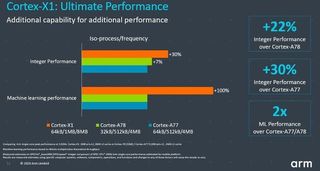Meet ARM's Cortex-X, the design that could create custom Pixel chips

ARM announced new CPU designs for 2020 and one of them is something nobody saw coming — a program that would help companies that make processors build specially customized chips targeting specific user-facing improvements.
You might have read about how the new Cortex-X1 CPU will be 22% faster than the new Cortex A78 design, but that doesn't do the new Cortex-X program justice. The exciting part of it all is how companies like Qualcomm, Samsung, or even Google could work with ARM and build a chip that's a fully customized reference design. In other words, the people who invented the technology will help make it work for a specific use case.
Cores can be big and fast or little and slow — it all depends on how long you want the battery to last.
There is no magic involved. A CPU is made of individual processing units called cores. You've heard of dual-core or octa-core processors before, and that simply means that the actual silicon has two or eight separate processing units built into a single chip. Each core can crunch numbers independently of the other cores, and logic dictates that more cores mean a more powerful chip.
But that's not really the case. You can only fit so many CPU cores inside a chip's physical design. More cores mean more power is needed and more heat is created — both of which are things chip designers really want to avoid. This is why multi-core CPUs usually use an arrangement of cores that are designed to wake up and sleep based on how much computing power is needed.

Every company that makes mobile CPUs does this, but some do it better than others. Apple and Qualcomm come to mind, and while each company approaches things a little differently, both use the same principle: there are "big" cores that are power-hungry and can crunch data very fast, and "little" cores that don't use nearly as much power but are a good bit slower. When your phone needs the power, the big cores ramp up and deliver. When your phone doesn't, the little cores keep everything running smoothly while the big cores sleep.
More: The cheapest iPhone has a more powerful processor than the most expensive Android phone
Apple and Qualcomm are really good at building custom CPU cores using ARM's basic design. Apple's chips may be more powerful based on pure number crunching, but Qualcomm's Snapdragon line of SoCs are still capable of delivering the processing power needed in a modern smartphone. What the Cortex-X program does is allow other companies that might not be as proficient at CPU core design to compete on the same level.
Be an expert in 5 minutes
Get the latest news from Android Central, your trusted companion in the world of Android
This is really important. MediaTek has spent a lot of money trying to design a custom SoC that can compete with the Snapdragon series. The Dimensity line looks like it's coming very close and being able to work with ARM to design a powerful computing core would go a long way to narrowing the remaining performance gaps.
Apple and Qualcomm will benefit from the new Cortex-X program, but so will MediaTek and Samsung. Maybe even Google.
Even more interesting is Samsung. Last year, Samsung announced two significant updates to its division that designs custom ARM processors. The first was a partnership with AMD for using Radeon GPU tech, and the second is that it was abandoning the idea of building its own designs entirely. With the news from ARM, Samsung's head of SoC design Joonseok Kim had the following to say:
Samsung and Arm have a strong technology partnership and we are very excited to see the new direction Arm is taking with the Cortex-X Custom program, enabling innovation in the Android ecosystem for next-gen user experiences.
The current "production" model from the Cortex-X line is the Cortex-X1, and it's built to be a powerhouse. With single core-performance that rivals Apple's A13 chip (the A14 should be in production by the time the Cortex-X1 becomes available), it would be possible for Samsung and AMD to build a mobile SoC using a "bigger-big-little" configuration. The X1 can wake up and do the heavy lifting when needed in tandem with the fast Cortex A78 cores, then power down when it's no longer needed. When a chip using this sort of arrangement is built correctly, all the end-user sees is plenty of speed and power from the processor to do exactly what they need it to do, and battery life isn't hit very hard because the bigger fast core is in hibernation most of the time.
Besides the great news for MediaTek and Samsung that the Cortex-X program brings, there's one very specific partner that jumps to the front of my mind: Google.

Google already designs powerful ARM cores for its Machine Learning centers and servers, but those involve big heatsinks and AC power. It's not very likely that much of those design ideas are going to apply when it comes to a small handheld device that's powered by a battery. But rumor says that Google is building out its own mobile SoC as early as 2021, and I think the Cortex-X program is what would make it possible.
More: Google may ditch Qualcomm and use its own chipsets in Pixel phones in 2021
Working with ARM could let Google build a fast, but power-efficient chip for smartphones using Cortex-X cores optimized to Google's expectations; you don't have to build a Cortex-X core for raw speed and could instead opt-in for a blend of power and efficiency. The Cortex-X1 supports a neural engine that's two times faster than previous versions and a new Mali G78 GPU means graphics are processed fast. Were Google to customize CPU cores in tandem with moving its neural engine to ARM's design, seeing a new chip designed by Google (with ARM's help) in just a year could be possible.
What ARM is showing us today is built for devices like foldable, where it's expected to do more because of the benefit of a bigger display. What we see in the future through the Cortex-X program is anyone's guess.
Sony's AI-powered sensors are the future of smartphone cameras

Jerry is an amateur woodworker and struggling shade tree mechanic. There's nothing he can't take apart, but many things he can't reassemble. You'll find him writing and speaking his loud opinion on Android Central and occasionally on Twitter.
